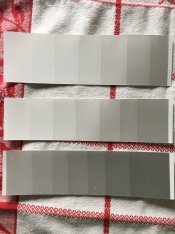I ran into some problems calibrating my analyser pro yesterday. Wondering if anyone can help shed some light on where I'm going wrong?
I've been using the analyser successfully with the built-in settings for Ilford Multigrade IV paper (I'm using satin resin coated paper) but I thought I'd try and improve the performance by calibrating it with my enlarger.
Materials and set-up:
Durst M707 colour enlarger (with the colour filters swung out of the way)
Ilford Multigrade under-lens filters
Ilford MGIV RC paper (fresh two weeks ago)
Ilford Multigrade developer and fix (freshly opened yesterday)
I followed the instructions in the manual and by raising the enlarger head and stopping down the lens obtained an initial measurement of just under 17 seconds. I set the step size to 1/4th second for the first three soft grades and ran a grade 00 test strip. This looked as I would expect, so I continued with grades 0 and 1. Again all fine (top and middle test strips in the attached photo are grades 00 and 0). As suggested in the manual, I changed to 1/6th second for grades 2 and 3 which also looked good.
However, I ran into problems when I tried a grade 4 test strip. I switched to a 1/12th second step size, and grade 4 gave me an exposure time of just over 50 seconds. This seemed a bit high, which was confirmed when looking at the test (bottom strip in the photo). As you can see it's a lot darker than the other two and none of the exposures match the calibration tile.
I had another look though the manual and spotted the note about reducing the exposure by one stop when using a colour enlarger. I did this (by hitting the reduce exposure button twelve times) and ran another test. This one came out completely blank. I.e. all white. I ran a second test with a new piece of paper, in case I'd exposed the back by mistake, but again, same blank test strip.
Queston 1: Thinking about this today, I presume I've misinterpreted the note in the manual about colour enlargers, and they are actually talking about when you use the built in filters in colour enlargers. Is that correct, or am I still missing something?
Question 2: If the above is correct, any idea what's going wrong and what to do about it?
Question 3: To get a lighter print, could I reduce the exposure by half a stop (six clicks of the exposure button) and compensate for that by subtracting 6 from the correction factor?
Question 4: Should I be running all seven test strips using 1/4th second steps to begin with, and only use the finer steps if I want to improve the accuracy later, or am I okay doing what I have been and changing them between grades?
Any pointers would be much appreciated.
I've been using the analyser successfully with the built-in settings for Ilford Multigrade IV paper (I'm using satin resin coated paper) but I thought I'd try and improve the performance by calibrating it with my enlarger.
Materials and set-up:
Durst M707 colour enlarger (with the colour filters swung out of the way)
Ilford Multigrade under-lens filters
Ilford MGIV RC paper (fresh two weeks ago)
Ilford Multigrade developer and fix (freshly opened yesterday)
I followed the instructions in the manual and by raising the enlarger head and stopping down the lens obtained an initial measurement of just under 17 seconds. I set the step size to 1/4th second for the first three soft grades and ran a grade 00 test strip. This looked as I would expect, so I continued with grades 0 and 1. Again all fine (top and middle test strips in the attached photo are grades 00 and 0). As suggested in the manual, I changed to 1/6th second for grades 2 and 3 which also looked good.
However, I ran into problems when I tried a grade 4 test strip. I switched to a 1/12th second step size, and grade 4 gave me an exposure time of just over 50 seconds. This seemed a bit high, which was confirmed when looking at the test (bottom strip in the photo). As you can see it's a lot darker than the other two and none of the exposures match the calibration tile.
I had another look though the manual and spotted the note about reducing the exposure by one stop when using a colour enlarger. I did this (by hitting the reduce exposure button twelve times) and ran another test. This one came out completely blank. I.e. all white. I ran a second test with a new piece of paper, in case I'd exposed the back by mistake, but again, same blank test strip.
Queston 1: Thinking about this today, I presume I've misinterpreted the note in the manual about colour enlargers, and they are actually talking about when you use the built in filters in colour enlargers. Is that correct, or am I still missing something?
Question 2: If the above is correct, any idea what's going wrong and what to do about it?
Question 3: To get a lighter print, could I reduce the exposure by half a stop (six clicks of the exposure button) and compensate for that by subtracting 6 from the correction factor?
Question 4: Should I be running all seven test strips using 1/4th second steps to begin with, and only use the finer steps if I want to improve the accuracy later, or am I okay doing what I have been and changing them between grades?
Any pointers would be much appreciated.












